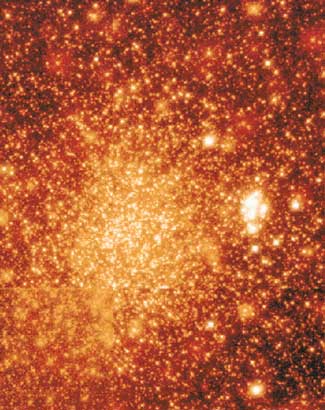 |
Nearly 10,000 stars fill this portion of the Large Magellanic Cloud, a nearby galaxy gradually spiraling into the Milky Way. Despite the crowded appearance of the field, the stars themselves are so far apart that smash-ups between the two galaxies' stellar inhabitants are highly unlikely. |
elements. The protons, nuclei, and electrons then waited for the universe to chill further, just as we might wait for our soup to cool at dinner. But whereas we wait a few minutes before sipping, the primordial matter waited another 300,000 years or so until the temperature dropped to a frosty 4,000 degrees. Only then was it cool enough for the electrons to join with the protons and the heavier nuclei to form atoms, an event called recombination.
This original Big Bang recipe for the cosmos yielded, by weight, about 75 percent hydrogen and 25 percent helium. There was a soupçon of other elements as well, including lithium, beryllium, and one one-thousandth of a percent deuterium. But the Big Bang produced not a single atom of carbon, oxygen, calcium, iron, or any other heavy element. Those ingredients for planets and life were generated by the second and ongoing phase of nucleosynthesis in the universe. The factories that churn out the heavy elements, astrophysicists realized during the twentieth century, are the stars in the sky.
The original set of cosmic ingredients spawned the first stars. Gravity pulled together pockets of matter that started with slightly higher densities, a slow process that probably took several million years. In time these prenatal stars became hot and dense enough at their cores to ignite the fires of thermonuclear fusion. Hydrogen atoms in the cores fused into new atoms of helium, losing a tiny amount of mass along the way. That "lost" mass became energy in accordance with Einstein's famous equation, E = mc2. The energy flowed out from the cores of the newborn stars, providing the heat and pressure needed to balance any further contractions from the inward force of gravity. This continual balancing act of gravity versus nuclear fusion characterizes the lives of adult stars.
All stars are large balls of electrically charged gas, called plasma. Perhaps because of science fictionstyle plasma ray guns, most people think of plasmas as exotic, energetic, and hot. That's true in a star, but in fact plasmas also are common on Earth. When we touch a metal doorknob after shuffling our feet across a carpet, that small spark we feel is an electrical charge running through a plasma pathway in the air that arose milliseconds before the shock. The same process occurs with lightning, albeit on (continued) |

